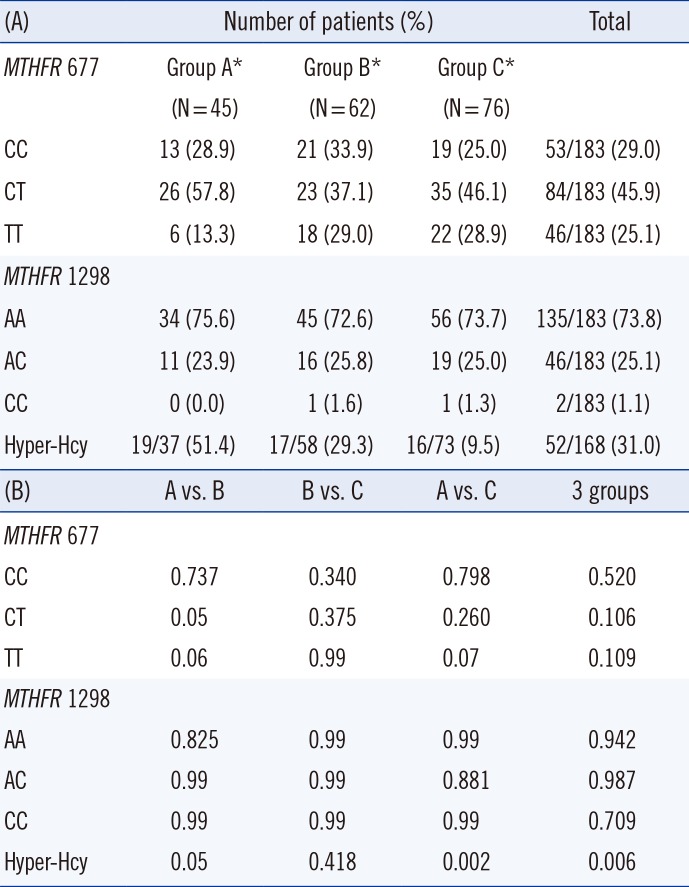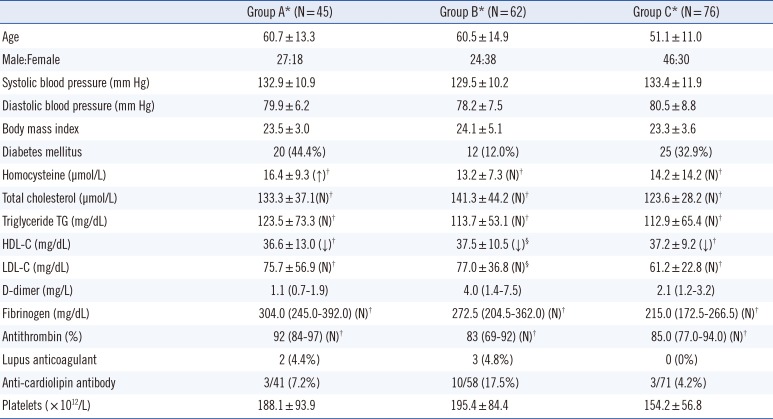1. 1999 World Health Organization-International Society of Hypertension Guidelines for the Management of Hypertension. Guidelines Subcommittee. J Hypertens. 1999; 17:151–183. PMID:
10067786.
2. Kearney PM, Whelton M, Reynolds K, Muntner P, Whelton PK, He J. Global burden of hypertension: analysis of worldwide data. Lancet. 2005; 365:217–223. PMID:
15652604.

3. Pedrinelli R, Ballo P, Fiorentini C, Denti S, Galderisi M, Ganau A, et al. Hypertension and acute myocardial infarction: an overview. J Cardiovasc Med (Hagerstown). 2012; 13:194–202. PMID:
22317927.
4. Gaciong Z, Siński M, Lewandowski J. Blood pressure control and primary prevention of stroke: summary of the recent clinical trial data and meta-analyses. Curr Hypertens Rep. 2013; 15:559–574. PMID:
24158454.

5. Wolf PA, D'Agostino RB, Belanger AJ, Kannel WB. Probability of stroke: a risk profile from the Framingham Study. Stroke. 1991; 22:312–318. PMID:
2003301.

6. Yano Y, Stamler J, Garside DB, Daviglus ML, Franklin SS, Carnethon MR, et al. Isolated systolic hypertension in young and middle-aged adults and 31-year risk for cardiovascular mortality: the Chicago Heart Association Detection Project in Industry study. J Am Coll Cardiol. 2015; 65:327–335. PMID:
25634830.
7. Ageno W, Becattini C, Brighton T, Selby R, Kamphuisen PW. Cardiovascular risk factors and venous thromboembolism: a meta-analysis. Circulation. 2008; 117:93–102. PMID:
18086925.
8. Mahan CE, Fanikos J. New antithrombotics: the impact on global health care. Thromb Res. 2011; 127:518–524. PMID:
21529897.

9. Cordoba I, Pegenaute C, González-López TJ, Chillon C, Sarasquete ME, Martin-Herrero F, et al. Risk of placenta-mediated pregnancy complications or pregnancy-related VTE in VTE-asymptomatic families of probands with VTE and heterozygosity for factor V Leiden or G20210 prothrombin mutation. Eur J Haematol. 2012; 89:250–255. PMID:
22642978.

10. Saemundsson Y, Sveinsdottir SV, Svantesson H, Svensson PJ. Homozygous factor V Leiden and double heterozygosity for factor V Leiden and prothrombin mutation. J Thromb Thrombolysis. 2013; 36:324–331. PMID:
23054468.

11. Clarke R, Bennett DA, Parish S, Verhoef P, Dötsch-Klerk M, Lathrop M, et al. Homocysteine and coronary heart disease: meta-analysis of MTHFR case-control studies, avoiding publication bias. PLoS Med. 2012; 9:e1001177. PMID:
22363213.

12. Gao XH, Zhang GY, Wang Y, Zhang HY. Correlations of MTHFR 677C>T polymorphism with cardiovascular disease in patients with end-stage renal disease: a meta-analysis. PLoS One. 2014; 9:e102323. PMID:
25050994.
13. Gariglio L, Riviere S, Morales A, Porcile R, Potenzoni M, Fridman O. Comparison of homocysteinemia and MTHFR 677CT polymorphism with Framingham Coronary Heart Risk Score. Arch Cardiol Mex. 2014; 84:71–78. PMID:
24793554.

14. Fukasawa M, Matsushita K, Kamiyama M, Mikami Y, Araki I, Yamagata Z, et al. The methylentetrahydrofolate reductase C677T point mutation is a risk factor for vascular access thrombosis in hemodialysis patients. Am J Kidney Dis. 2003; 41:637–642. PMID:
12612987.

15. Soltanpour MS, Soheili Z, Shakerizadeh A, Pourfathollah AA, Samiei S, Meshkani R, et al. Methylenetetrahydrofolate reductase C677T mutation and risk of retinal vein thrombosis. J Res Med Sci. 2013; 18:487–491. PMID:
24250697.
16. Spiroski I, Kedev S, Antov S, Arsov T, Krstevska M, Dzhekova-Stojkova S, et al. Association of methylenetetrahydrofolate reductase (MTHFR-677 and MTHFR-1298) genetic polymorphisms with occlusive artery disease and deep venous thrombosis in Macedonians. Croat Med J. 2008; 49:39–49. PMID:
18293456.

17. Kara H, Bayir A, Degirmenci S, Kayis SA, Akinci M, Ak A, et al. D-dimer and D-dimer/fibrinogen ratio in predicting pulmonary embolism in patients evaluated in a hospital emergency department. Acta Clin Belg. 2014; 69:240–245. PMID:
25012747.

18. D'Angelo A, Selhub J. Homocysteine and thrombotic disease. Blood. 1997; 90:1–11. PMID:
9207431.
19. Lin LJ, Cheng MH, Lee CH, Wung DC, Cheng CL, Kao Yang YH. Compliance with antithrombotic prescribing guidelines for patients with atrial fibrillation--a nationwide descriptive study in Taiwan. Clin Ther. 2008; 30:1726–1736. PMID:
18840379.

20. Sode BF, Allin KH, Dahl M, Gyntelberg F, Nordestgaard BG. Risk of venous thromboembolism and myocardial infarction associated with factor V Leiden and prothrombin mutations and blood type. CMAJ. 2013; 185:E229–E237. PMID:
23382263.

21. Bozok Çetintaş V, Gündüz C. Association between polymorphism of MTHFR c.677C>T and risk of cardiovascular disease in Turkish population: a meta-analysis for 2.780 cases and 3.022 controls. Mol Biol Rep. 2014; 41:397–409. PMID:
24264431.
22. Neff MJ. ACEP. ACEP releases clinical policy on evaluation and management of pulmonary embolism. Am Fam Physician. 2003; 68:759–760. PMID:
12952389.
23. Schutgens RE, Ackermark P, Haas FJ, Nieuwenhuis HK, Peltenburg HG, Pijlman AH, et al. Combination of a normal D-dimer concentration and a non-high pretest clinical probability score is a safe strategy to exclude deep venous thrombosis. Circulation. 2003; 107:593–597. PMID:
12566372.

24. Misita CP, Moll S. Antiphospholipid antibodies. Circulation. 2005; 112:e39–e44. PMID:
16027261.

25. Fagher B, Sjögren A, Sjögren U. Platelet counts in myocardial infarction, angina pectoris and peripheral artery disease. Acta Med Scand. 1985; 217:21–26. PMID:
3976430.

26. Pengo V, Tripodi A, Reber G, Rand JH, Ortel TL, Galli M, et al. Update of the guidelines for lupus anticoagulant detection Subcommittee on Lupus Anticoagulant/Antiphospholipid Antibody of the Scientific and Standardisation Committee of the International Society on Thrombosis and Haemostasis. J Thromb Haemost. 2009; 7:1737–1740. PMID:
19624461.
27. Nygård O, Vollset SE, Refsum H, Brattström L, Ueland PM. Total homocysteine and cardiovascular disease. J Intern Med. 1999; 246:425–454. PMID:
10583714.

28. Chang JD, Hur M, Lee SS, Yoo JH, Lee KM. Genetic background of nontraumatic osteonecrosis of the femoral head in the Korean population. Clin Orthop Relat Res. 2008; 466:1041–1046. PMID:
18350352.

29. Kim YW, Yoon KY, Park S, Shim YS, Cho HI, Park SS. Absence of factor V Leiden mutation in Koreans. Thromb Res. 1997; 86:181–182. PMID:
9175239.
30. Joachim E, Goldenberg NA, Bernard TJ, Armstrong-Wells J, Stabler S, Manco-Johnson MJ. The methylenetetrahydrofolate reductase polymorphism (MTHFR c.677C>T) and elevated plasma homocysteine levels in a U.S. pediatric population with incident thromboembolism. Thromb Res. 2013; 132:170–174. PMID:
23866722.
31. Lee SY, Kim HY, Park KM, Lee SY, Hong SG, Kim HJ, et al. MTHFR C677T polymorphism as a risk factor for vascular calcification in chronic hemodialysis patients. J Korean Med Sci. 2011; 26:461–465. PMID:
21394321.
32. Aucella F, Margaglione M, Grandone E, Vigilante M, Gatta G, Forcella M, et al. The C677T methylenetetrahydrofolate reductase gene mutation does not influence cardiovascular risk in the dialysis population: results of a multicentre prospective study. Nephrol Dial Transplant. 2005; 20:382–386. PMID:
15618240.

33. Haviv YS, Shpichinetsky V, Goldschmidt N, Atta IA, Ben-Yehuda A, Friedman G. The common mutations C677T and A1298C in the human methylenetetrahydrofolate reductase gene are associated with hyperhomocysteinemia and cardiovascular disease in hemodialysis patients. Nephron. 2002; 92:120–126. PMID:
12187094.

34. Wrone EM, Zehnder JL, Hornberger JM, McCann LM, Coplon NS, Fortmann SP. An MTHFR variant, homocysteine, and cardiovascular comorbidity in renal disease. Kidney Int. 2001; 60:1106–1113. PMID:
11532106.

35. Antoniades C, Antonopoulos AS, Tousoulis D, Marinou K, Stefanadis C. Homocysteine and coronary atherosclerosis: from folate fortification to the recent clinical trials. Eur Heart J. 2009; 30:6–15. PMID:
19029125.

36. Park KH, Han SJ, Kim HS, Kim MK, Jo SH, Kim SA, et al. Impact of Framingham risk score, flow-mediated dilation, pulse wave velocity, and biomarkers for cardiovascular events in stable angina. J Korean Med Sci. 2014; 29:1391–1397. PMID:
25368493.

37. Vuckovic BA, Cabarkapa VS, Ilic TA, Salatic IR, Lozanov-Crvenkovic ZS, Mitic GP. Clinical significance of determining plasma homocysteine: case-control study on arterial and venous thrombotic patients. Croat Med J. 2013; 54:480–488. PMID:
24170727.

38. Brattström L, Wilcken DE. Homocysteine and cardiovascular disease: cause or effect? Am J Clin Nutr. 2000; 72:315–323. PMID:
10919920.

39. Paul GK, Sen B, Bari MA, Rahman Z, Jamal F, Bari MS, et al. Correlation of platelet count and acute ST-elevation in myocardial infarction. Mymensingh Med J. 2010; 19:469–473. PMID:
20639847.
40. Monreal M, Lafoz E, Casals A, Ruiz J, Arias A. Platelet count and venous thromboembolism. A useful test for suspected pulmonary embolism. Chest. 1991; 100:1493–1496. PMID:
1959389.







 PDF
PDF ePub
ePub Citation
Citation Print
Print


 XML Download
XML Download